![]() 1st Battalion 22nd Infantry
1st Battalion 22nd Infantry ![]()
Arrival in the Philippines and the Pasig Expedition 1899
![]()
Campaign Streamer awarded to the 22nd
Infantry for service
during the Pasig Expedition
After the Spanish American War
the 22nd Infantry lost a large number of Soldiers to disease and
end of enlistments.
During the latter part of 1898 the Regiment's ranks were
replenished with a great many new, and for the most part,
raw recruits. A hurried training program was initiated for these
recruits at Fort Crook. How they would perform
in a combat environment as harsh as the Philippines was unknown.
As was later attested to in the Regimental Histories
and after-action reports these new recruits learned quickly, and
aquitted themselves professionally,
adding to the long line of service of the Regiment.
The 22nd Infantry arrived in the
Philippines in the early part of March, 1899, after the defeat of
the Spanish.
US forces held the city of Manila when the Regiment landed there.
War had already been declared by the Filipinos
while the Regiment was still at sea. The Filipino insurgent army,
led by Aguinaldo, was spread out around Manila,
mostly to the north and east of the city. A large body of the
insurgent army was headquartered at Pasig, to the east.
The first campaign of the war mounted by the US against the
insurgency was against those enemy forces at Pasig.
The mission was to either destroy them, or drive them north, so
as to make them link up with Aguinaldo's forces
in the northern part of the island, and therefore create a single
front with which the Americans would have to contend.
Within a week of landing on Philippine soil, the 22nd Infantry became an integral part of that first campaign.
The following article
describes in detail, the loading and departure of the 22nd
Infantry
from San Francisco, for duty in the Philippines, February 1,
1899.
The article is incorrect
when it names Lieutenant Colonel Patterson as being second in
command of the Regiment.
LTC John Patterson was not with the 22nd Infantry at this time.
He was in the process of retiring from the Army,
which he did on February 6, 1899.
Major Leopold O. Parker,
mentioned in the article as being in command of the Army
personnel on the ship Ohio,
was actually second in command of the Regiment at this time.
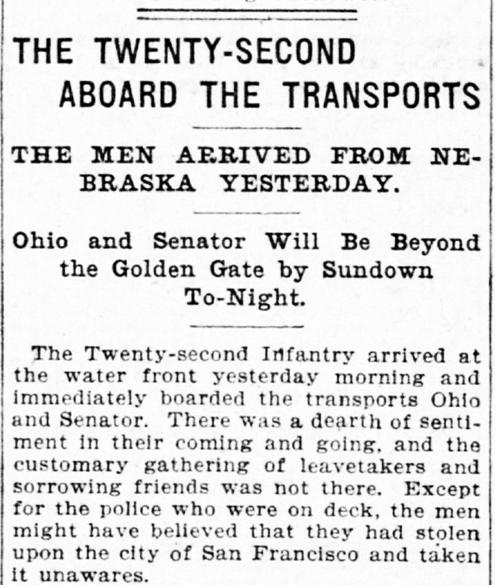
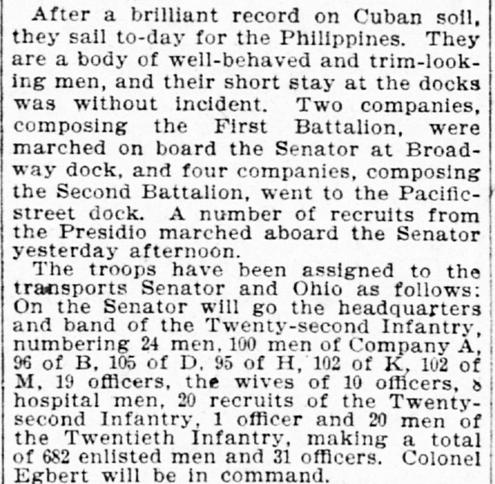
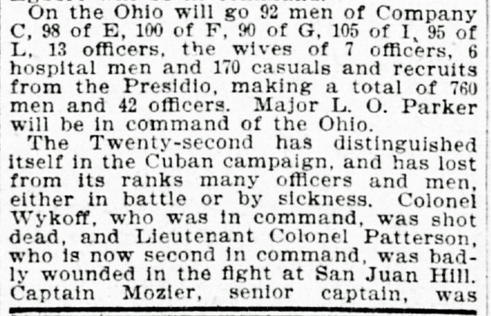
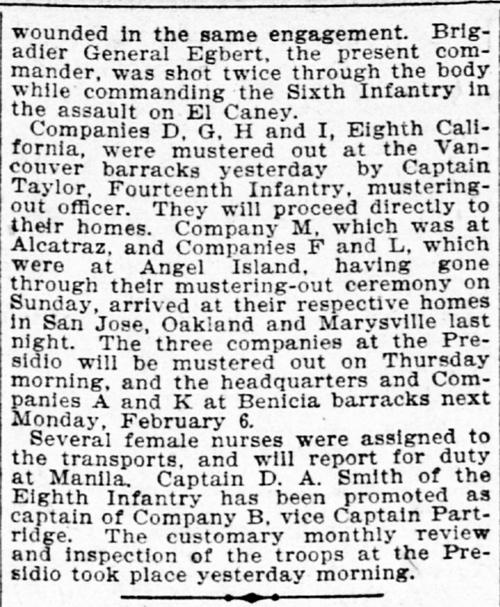
Article from The San Francisco Call, Wednesday, February 1, 1899
CDNC California Digital Newspaper Collection
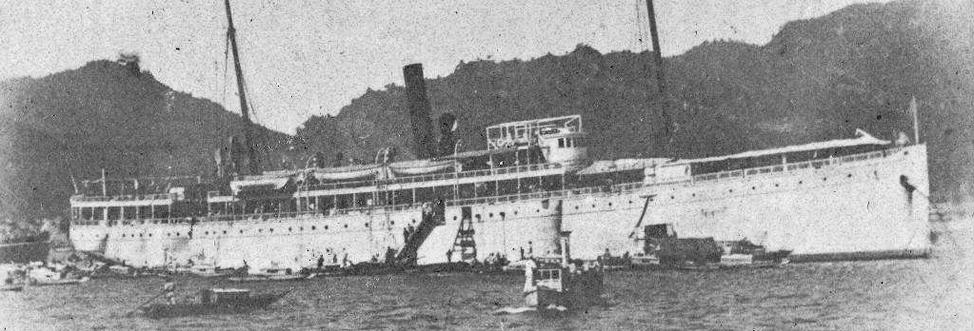
The transport Senator
as she appeared in 1899. The Senator
carried the 22nd Infantry Headquarters, Regimental Band and
Companies A, B, D, H, K and M to the Philippines in 1899.
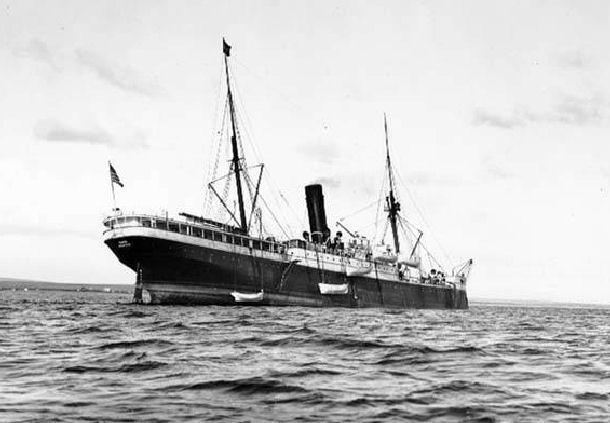
The transport Ohio. The Ohio carried Companies C, E, F, G, I and L to the Philippines in 1899.
Photo from the Poulton Web website
The following narrative is taken from the Regimental histories compiled in 1904 and 1922
Character of the Enemy and Events Leading up to the Insurrection
The 22nd Infantry spent a
comparatively short time in inaction after the close of the
Spanish-American war.
On January 27, 1899, the command left Fort Crook and proceeded by
rail to San Francisco, California,
bound for the Philippines and more adventure. (Ed., The 1st
Battalion left Fort Crook on January 26,
the rest of the Command left the next day, January 27.)
The regiment did not waste much
time in California.
Arriving there January 31, on the following day twenty-six
officers and one thousand and seventy enlisted men
boarded the chartered transports Senator and Ohio and sailed for
our new possessions in the Far East.
The first night at sea an enlisted man was washed overboard and
drowned.
(Ed., The man lost overboard was
Corporal George A. Abbott, of Company D.
In the 1904 Regimental History two other deaths were also
recorded during the voyage. On February 6 Private James T. Larkin
of Company I, and on March 2 Private Clarence R. Overton of
Company G. Both were recorded as "Died of Disease".
Private Overton was a passenger on the Ohio, and actually died of
spinal meningitis, according to newspaper reports of the day.)
The transports stopped at
Honolulu to coal, February 9 to 13. The Senator arrived in Manila
bay March 4; the Ohio March 5.
During the voyage the Filipinos had rebelled against the
authority of the United States and when the 22nd arrived,
Manila, in possession of the Americans, was invested on the land
side by insurgent armies.
The regiment disembarked March 5 and 6, occupied Malate barracks
and equipped for tropical service.
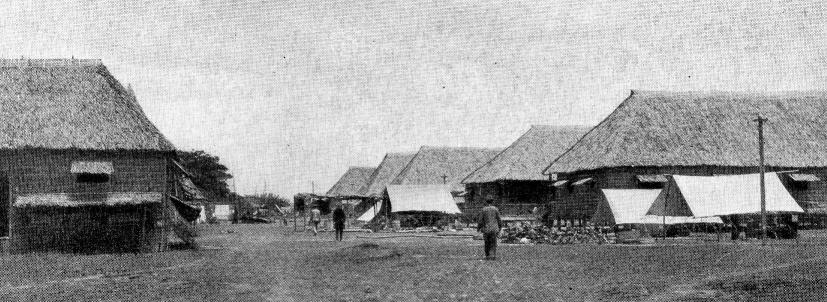
The thatch-roofed barracks at Malate
Photo from the Regimental History of 1904
March 10, Companies B, C, H and
L, were assigned to a position on the line of outposts to the
southwest of San Pedro Macati.
Since shortly after the beginning of hostilities, February 4,
1899, the American line south of the Pasig river
had extended from San Pedro Macati southwesterly to Manila bay.
This line was intrenched and was opposed by insurgent forces
along its entire front. Shots were exchanged daily. Night attacks
by the insurgents were frequent;
the regiment suffered casualties almost as soon as they took
position on the line. (Ed., Wounded in action on March 11 was
Private Marshall Combs of Company B and Private Amos W.
Seigenthaler of Company C.)
Beyond the fact that Pasig City
was an insurgent stronghold and that the smaller towns were
occupied
and levied upon by the Filipino soldiery, little was known of the
strength and position of the enemy.
Aguinaldo, with whose insurrection the 22nd Infantry was now
intimately concerned, was a wily and unscrupulous enemy.
After the destruction of the Spanish fleet in Manila bay the
native leader, under advice of the Hong Kong junta,
proceeded from that city to Manila with the intention of securing
as much aid as possible from the United States,
and then, when sufficiently strong, of driving out the Americans.
His course throughout was consistent with this well-settled
intention. His declaration of independence of June, 1898;
his capture during the succeeding seven months of the weakly
garrisoned posts throughout the islands,
by which he obtained large quantities of arms and ammunition; the
elimination from his so-called government of his able advisers,
who advocated United States supremacy; his declared dictatorship;
the concentration of his troops
and the building of intrenchments and fortifications around
Manila; the public demonstrations and rejoicing at his capital of
Malolos
on the anticipated victory shortly before hostilities were
begun—all occurring in well-timed succession
prove conclusively a predetermined plan of action to place the
islands under Tagalog rule.
Prior to February 4, 1899, the date of the outbreak, all of
Aguinaldo's communications to General Otis—
and these were numerous—professed friendship toward the
United States and manifested great desire to restrain his people
from hostile acts.
January 9, he appointed a commission to confer with one to be
appointed by General Otis, "for the sake of peace",
as he expressed it. On the very same day, with marvelous
duplicity, he issued a proclamation containing instructions
to "the brave soldiers of Sandatahan of Manila''. This
proclamation contained instructions in minute detail for the
waging of treachery and death
upon the Americans, discussed methods of attack and massacre and
urged all manner of deceit
in methods of gaining access to close quarters with American
soldiers for the purpose of surprise onslaughts.
Natives were ordered to dress as women in order to kill
sentinels. Stones, timbers, red-hot iron, heavy furniture,
boiling oil,
water and molasses and rags soaked in oil and lighted were to be
thrown on the Americans from the house-tops.
Native women were to be pressed into service to prepare boiling-
water, molasses and other liquids
to be used against the troops of the United States.
On the 4th of February,
following the proclamation of the insurrecto chief, the first
shot of the war was fired by a Nebraska outpost
at a Filipino soldier who was advancing on our lines and who
refused to halt.
This shot was immediately followed by general firing all along
the line, the Filipinos receiving severe punishment.
Aguinaldo at once issued his declaration of war in a
"general order to the Philippine Army" as follows:
Nine, o'clock, p. M., this
date, I received from Caloocan station a message communicated to
me
that the American forces, without prior notification or any just
motive, attacked our camp
at San Juan del Monte and our forces garrisoning the blockhouse
around the outskirts of Manila,
causing losses among our soldiers, who in view of this unexpected
aggression and of the decided attack of the aggressors,
were obliged to defend themselves until the firing became general
all along the line.
No one can deplore more than I this rupture of hostilities. I
have a clear conscience that I have endeavored to avoid it
at all costs, using all my efforts to preserve friendship with
the army of occupation at the cost of not a few humiliations
and many sacrificed rights. But it is my unavoidable duty to
maintain the integrity of the national honor
and that of the army so unjustly attacked by those who, posing as
our friends and liberators, attempt to dominate us
in place of Spaniards, as is shown by the grievances enumerated
in my manifest of January 8,
last; such as the continued outrages and violent exactions
committed against the people of Manila,
the useless conferences, and all my frustrated efforts in favor
of peace and concord.
Summoned by this unexpected provocation, urged by the duties
imposed upon me by honor and patriotism
and for the defense of the nation entrusted to me, calling on God
as a witness of my good faith and uprightness of my
intention———
I order and command :
1.—Peace and friendly relations between the Philippine
forces and the American forces of occupation are broken,
and the latter will be treated as enemies, with the limits
prescribed by the laws of war.
2.—American soldiers who may be captured by the Philippine
forces will be treated as prisoners of war.
3.—This proclamation shall be communicated to the accredited
consuls of Manila, and to congress,
in order that it may accord the suspension of the constitutional
guarantees and the resulting declaration of war.
Given at Malolos, February 4, 1899.
(Sgd) EMILIO AGUINALDO,
General-in-Chief.
The following day Aguinaldo
issued another manifesto addressed to the Philippine people
in which he disclaimed all responsibility for the rupture,
placing all the blame on the Americans
and assuring the natives that they could resist the occupation as
long as they wanted to.
The following day Aguinaldo issued instructions marked with the
most savage ferocity.
For the sake of independence, all Americans—men, women and
children—were to be massacred.
For policy's sake, English, French and Germans, their lives and
their property, were to be spared.
But for oriental greed's sake, all Chinamen were to be put to the
sword;
to appease the wily chieftain's half barbarous army, the property
of Chinamen was to be subject to loot.
If these acts had been carried into execution, justification
undoubtedly would have been made
in extravagantly worded phrases prating of liberty. Fortunately,
American arms prevented the wholesale slaughter.
Such was the character of the enemy the regiment was to oppose.
Added to this duplicity
were arms and munitions of war in great abundance. The terrain of
the country, superbly suited to check the American advance,
afforded additional advantage. That our forces never suffered
reverses in the islands in no way proves that the Filipinos were
poor fighters.
Ed. note: The preceding
paragraphs are taken from the 1922 Regimental history, and are a
condensation and summary
of three proclamations issued by Aguinaldo on January 9, and
February 4 and 5, 1899. In the 1904 Regimental history all three
of these proclamations are printed in full, and take up nearly
five pages of the book. The January 9 proclamation
gruesomely details Aguinaldo's instructions to the
"Sandatahan of Manila", as he called his army, in
prescribing
methods of attacks upon and ways to kill Americans and Filipinos
who sympathized with Americans.

Some of Aguinaldo's Katipuneros
(Katipunan soldiers), wearing captured Spanish uniforms.
The Katipunan Society had been formed as a secret society to
resist and fight Spanish occupation.
When Aguinaldo declared war on the Americans he assimilated
Katipunan forces into his army.
A Filipino flag can be seen in the right center of the photo,
with its distinctive "Sun" emblem,
the design of which evolved directly from previous Katipunan
flags.
This "Sun"emblem of the Katipunans would, in 1923, be
incorporated into the heraldic design
of the Coat-of-Arms and Distinctive Unit Insignia of the 22nd
Infantry.
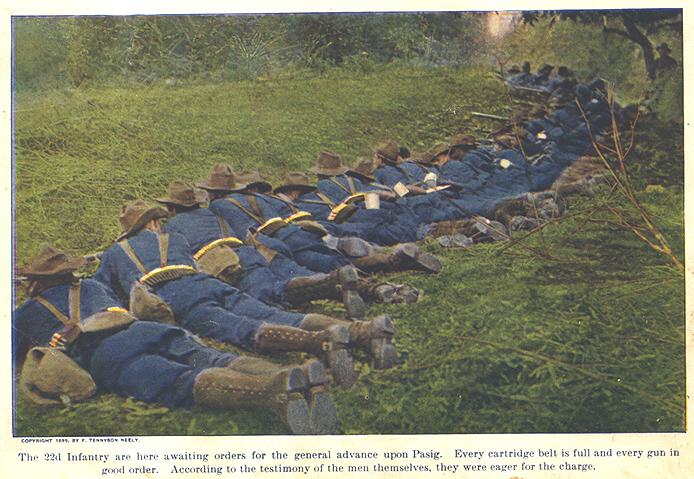
Illustration from a
period book showing the 22nd Infantry at Pasig.
The black & white photo has been color tinted, and the artist
has incorrectly
given the Soldiers blue uniforms.
Photo from:
A Wonderful Reproduction of LIVING SCENES In Natural Color Photos fo America's New Posssessions.
F. Tennyson Neely. New York, Chicago, London: 1899
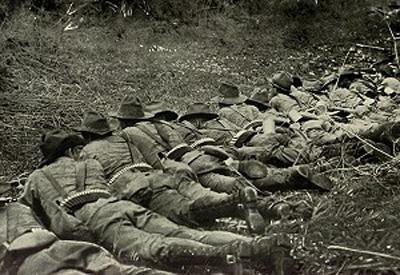
Section of the same
photo as above, but in the original black & white.
The tan or khaki color of their uniforms can be plainly seen;
had the uniforms been blue, (as the artist in the preceding photo
has portrayed them)
then in the black & white photo the uniforms would be darker
than the men's campaign hats.
The Pasig Expedition
Brigadier-General Loyd Wheaton,
commanding.
Troops Engaged:
Provisional Brigade consisting of:
20th Infantry; 22nd Infantry; two battalions 1st Washington
Volunteer Infantry; seven companies 2nd Oregon Volunteer
Infantry;
one platoon 6th Artillery, and three troops 4th Cavalry.
The Pasig expedition was the
first organized campaign against the insurgents, General
Wheaton's instructions being
to drive the enemy beyond the Pasig, "striking him wherever
found".
The night of March 12 the brigade was formed and bivouacked in
line in rear of entrenchments
extending from San Pedro Macati toward the bay. The 22nd Infantry
formed the right of the infantry line;
on the extreme right was a squadron of the 4th Cavalry.
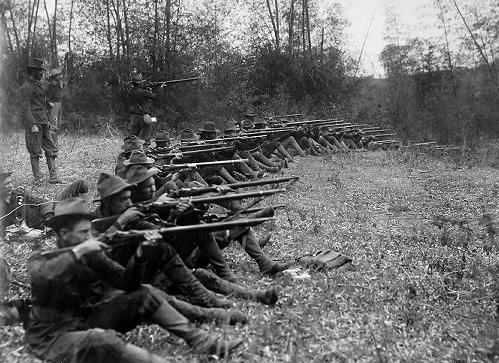
Soldiers of the 2nd
Oregon Volunteers prepare to fire a volley during the fight at
Pasig.
They are armed with the 45-70 caliber "trapdoor"
Springfield rifles. The 2nd Oregon
was part of BG Wheaton's Provisional Brigade alongside the 22nd
Infantry.
Captain Jacob Kreps, in command of Company M, 22nd Infantry, wrote of the night of March 12 :
"Rain
started to fall before we reached our destination. Company M
Passed a sister regiment—
the men standing on one foot, then the other, attempting to keep
dry—while, at the same time,
trying to keep a fire going and fry bacon.
After trudging
across several muddy rice fields, we took our position a few
hundred yards
to the rear of the trenches. A short distance beyond, was a
church occupied by an Oregon detachment.
The rain kept
up, more or less, all during the night. Everyone was
miserable—
especially the new recruits who were getting their first taste of
field service. Many of the men were without cover.
Very few took the trouble to put up their shelter
tents—preferring to have the canvas between themselves and
the ground—
rather than between their bodies and the sky. However, I can't
blame them.
In a Philippine rainstorm, a shelter tent gives about as much
protection as an equal size piece of wire netting." * 1
At six o'clock on the morning of
March 13 the brigade moved forward by echelon from the right,
the 22nd Infantry and the 4th Cavalry moving first. In front of
the regiment's position, the country was rough and broken;
trees and stumps of bamboo prevented extended vision; a series of
low ridges afforded the insurgents many superior positions.
From these hidden positions the enemy at once opened with long
range fire, to which it was impossible to reply;
for a time the regiment advanced under fire and in absolute
ignorance of the whereabouts of the insurgent strongholds.
"The
rookies of Company M heard a whistling noise and glanced
curiously at each other—
wondering if it was the sound of a lizard or some other animal.
Then another whistle—and the men quickly realized
that they were hearing their first hostile bullets. Heads
dodged—soldiers darted for the nearest cover and hugged the
ground.
They later
discovered, that if a bullet had time to sing a solo, it would be
distant—too far away to do any harm.
However, if it passed with a zip—a tree, mudbank, or stone
wall were handy bulwarks to have around.
The vicious pellets were never alone—they always had
companions following them."*
2
Shortly after the beginning of
the engagement the squadron of the 4th Cavalry was detached from
the line
and ordered to make a wide detour toward the Pasig River, to
intercept the insurgents' possible retreat in that direction ;
afterward Companies I and A of the regiment were sent to assist
the cavalry. Meanwhile the brigade had forced the enemy
from a strongly-intrenched and fortified position on Guadalupe
ridge. As the advance continued, the insurgents fell back,
fighting stubbornly until they reached the river, which they
crossed in disorder, receiving severe losses.
"We came
upon seven Filipinos on the riverbank. They all surrendered exept
one plucky fellow.
He threw his gun in the river and plunged in himself. Although
the water around him was churned by bullets,
I believe he succeeded in escaping." *
3
Meeting no further opposition at
this point, the brigade occupied the Pasig road, moved eastward
and encountered heavy fire from the Pasig intrenchments. Captain
Kreps was given command of D Company
in addition to M Company and ordered to clear the road:
"We crept
forward, slowly and carefully—rifles at the ready. A grove
of trees and banana plants soon obstructed our view—
but also hid us from the rebels. The trail suddenly curved
sharply, and for about a hundred yards the roadway was cut
through
a hill of solid rock. The stone walls rose thirty feet on both
sides of the path. At the far end of the gorge, the curve
straightened out
and came into full view of the opposite bank.
I decided to
take a few men and investigate. We sneaked through the cut until
I noticed the enemy positions
across the river. The Insurgent trenches controlled this part of
the road—and we soon discovered that they were manned by
sharpshooters.
My troops were spotted, and several straw hats popped into view
above the enemy earthworks.
Each hat represented a puff of smoke—a bang—then the
splatter of a bullet on the rock wall.
We quickly ran
for cover—out of sight from the enemy riflemen. That is, all
except Private William Reinhardt.
Several times the youngster stepped out into the middle of the
road—deliberately knelt, aimed, and fired—
then dashed back to the tunnel to reload. He tried this once too
often and was shot in the foot." *
4
The regiment moved farther to
the east and occupied high ground opposite the town.
From this position a destructive fire was opened on the insurgent
trenches. The armored gunboat Laguna de Bay was sent up
the river
to aid in the attack on the trenches. When the fire from these
trenches had been partly silenced,
the brigade charged the town, routing the enemy and inflicting
great losses upon them.
During this part of the engagement, Companies A and I, a mile
east of the main body, became seriously engaged
with a large body of retreating insurgents. Companies D, E, G and
M advanced to assist the two companies
and drove the enemy beyond Pateros, in the direction of Taguig.
Later in the day a number of insurgent sharpshooters returned to
Pateros,
and until long after dark kept up an annoying fire on the six
companies, whose position upon the river bank was entirely
exposed.
Ed., Killed in action on March 13 were:
Private George E. Stewart,
Company B,
-Private
Wesley J. Hennessy, Company D,
--Corporal
Wynne P. Munson, Company K.
Wounded in Action on March 13 were:
Private Daniel W. Carroll,
Company A--
Private John Mulvahill, Company D-----
Private William M. Harmon, Company D
Private William S. O'Brien, Company D-
Private Joseph Hoffman, Company E----
Private Joseph B. Cox, Company E-----
Private Theodore Misner, Company F---
Private John Blazek, Company I---------
Corporal James Comerford, Company M
Private William M. Reinhart, Company M
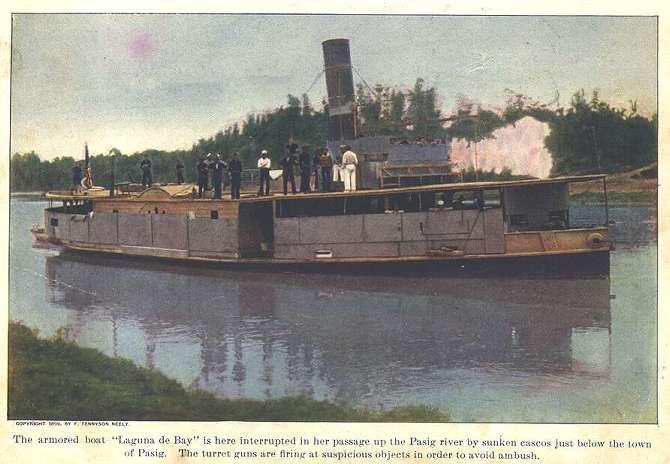
Laguna de Bay on the Pasig river.
A wooden vessel, her sides and bridge were protected by iron
plates.
This gunboat was instrumental in driving the insurgents from the
trenches around the town of Pasig.
Photo from:
A Wonderful Reproduction of LIVING SCENES
In Natural Color Photos fo America's New Posssessions.
F. Tennyson Neely. New York, Chicago, London: 1899
On the morning of the 14th the
remainder of the regiment was placed in position opposite
Pateros.
Here it remained on outpost until March 18. During this period,
the hardships of Philippine campaigning were first felt.
Heavy rains fell nightly during the week; shelter halves gave
little protection; toward morning officers and men,
drenched and shivering, were compelled to rise from their muddy
beds on the ground and sit around camp fires
until the sun finally appeared and dried the clothes on their
backs.
March 18 a force of the enemy
appeared near Taguig and Companies D, E, G and M were sent out to
locate them.
At about 3 o'clock in the afternoon the four companies found the
insurgents, 800 strong, occupying ridges west of Taguig,
and at once engaged them in one of the most spirited combats of
the war. The insurgents, from superior positions
and greatly outnumbering the battalion of the 22nd, fought until
darkness ended the engagement. During the battle
a Company of Washington Volunteers was pinned down by the
insurgents established on one of the ridges. Captain Kreps wrote:
"About
three o'clock, our depleted battalion was placed under the
command of Captain Frank Jones.
We were ordered to move out and attempt to rescue the besieged
company. However, our directive stated for us to proceed
down to the river and move forward along the bank. I protested
and asked permission to advance across the high ground.
General Wheaton denied my request. I considered his order
irresponsible. It would have been much safer advancing along the
ridge.
As it was, we could—and did—head into a trap.
Companies D, E,
and G formed the front line of the battalion with Company M in
reserve. After marching two miles, firing was heard.
We could make out the Washington outfit delivering
volleys—but there was no sign of the enemy.
Scouts suddenly brought word that there were about eight hundred
Insurgents to our front. I hoped that the size of the rebel force
was exaggerated—if correct, we were outnumbered four to one.
As we pushed on
ahead, the terrain became rough and rockstrewn— then cliffs
emerged on our right and left flanks.
Within a few minutes we found ourselves cornered in a horseshoe
shaped depression. High ground surrounded us on all sides—
except at the narrow entrance to the shoe. The lead companies had
proceeded about five hundred yards when the 'music' began.
A hailstorm of Mauser bullets rained down on the troops. Further
progress was impossible. The men dashed for cover
and commenced firing back at the enemy. But our front line was
suffering heavy casualties and ammunition was beginning to run
short.
Captain Jones
shouted orders for the battalion to retreat from the trap, and
directed Company M to protect the withdrawal.
However, the sudden wild, disorganized rush of men descended upon
my troops so rapidly that our company became intermingled
with the returning firing line. There was a great deal of
confusion as the retiring soldiers crowded through the narrow
opening
of the horseshoe—while, at the same time, we were trying to
move past them to the front. During the melee, Jones was shot
and I assumed command of the battalion.
It was a
madhouse of frustration. We were afraid to fire at the Filipinos
for fear of hitting our own troops
as they attempted to flee the trap. Meanwhile, Insurgent bullets
pelted down on us in a pitiless shower. Three of my men were
shot,
including Henry Johnson. I was finally able to reform Company M
as a line of skirmishers, and began a rapid fire assault
on the enemy positions. By the time that the rest of the
battalion was clear of the horseshoe, the Filipinos began to
retreat.
In a little over an hour, our battalion had lost twenty men—
killed or wounded. * 5
Ed., In Combat Diary A.B. Feuer sets the scene next, as Jacob Kreps writes down his feelings after a hard day of fighting:
"It was
nearly dark when the soldiers of Company M returned to their
tents. The sun had set, and a full moon looked down
upon the litter bearers hauling the dead and wounded from the
battlefield. The long line of stretchers—stopping every few
minutes
to change carriers— dragged its slow course back to camp.
Jacob Kreps was tired, bitter, and depressed after the furious
battle,
and he eloquently expressed his feelings in the pages of his
notebook:
'I searched the
hospital tents until I located Johnson. An enemy bullet had
entered just over the left eye and passed completely
through his head. The youngster never regained consciousness.
Johnson's brief service in the Army of the United States was
over—
but his dedication will not be soon forgotten.
The history of a soldier in the regular army, or any soldier for that matter, is the story of his organization while he is affiliated with it.
The hero is
usually of newspaper manufacture—and remains a hero for
possibly three editions. The soldier who falls in combat
needs no such notoriety. If his company or regiment never
disgraces its flag— but only adds to the brightness of its
colors—
this honor is shared with his comrades.
However, what
good is honor to Johnson now? His body lies on the island of
Luzon—sacrificed to a policy
not to be criticized by the soldier, but which has as its
objective the subjugation of a people fighting for their liberty.
Henry Johnson
died—not in defense of his country—but rather because
duty summoned him to that rugged,
rocky spot near Laguna de Bay where the messenger of death was
waiting. No sentiment nor feelings motivated his actions—
only the stern obligation to flag and country, ready to meet any
foe, domestic or foreign. Ready to obey the legal orders of his
superiors.
This is, and always will be, the function of the 'regular
soldier.'" * 6
The battalion lost nineteen men
killed and wounded; among the wounded Captain Frank B. Jones, the
battalion commander.
At daylight on the following day the brigade was deployed facing
toward the south, the regiment occupying the right of the line.
Wheeling on the left as a pivot, the brigade struck the
insurgents south of Taguig, routed them, and drove them down the
lake.
The regiment marched twelve miles in extended order during the
swinging movement. The heat was intense;
on the return march the command suffered severely; men dropped
from exhaustion and were brought in by comrades
whose condition was but little better. Near Taguig was seen
ghastly evidence of the previous day's engagements—
many corpses in insurgent uniforms. Considering the extreme care
exercised by the Filipinos in removing their dead,
the number thus left upon the field showed the great losses
Captain Jones' battalion had inflicted.
March 20, orders were received
from Manila disbanding the provisional brigade and ordering the
troops to return to Manila.
The object of the expedition had been thoroughly accomplished. In
the week's campaign, every position occupied by the enemy
in the territory assigned to the brigade had been attacked and
captured; the insurgent forces had been dispersed and
demoralized.
General Wheaton reported Aguinaldo's loss in killed, wounded and
captured as 2,500.
Ed., Killed in Action on March 18 were:
Private John Smith, Company E
------------Private Charles W. Fredericks, Company E
---------Private Henry W. Johnson, Company M
Wounded in Action on March 18 were:
Captain Frank B. Jones, -------
------Private
Berry H. Young, Company D
----Private
Nels Arvidson, Company D
--Private
Frank Yount, Company D
-Private
William Ellis, Company E
----Private
Leander Mings, Company E
-----Private
Carl Crumpholz, Company E
-------Private Charles E. Palmer, Company E
-Private
Robert Rice, Company E
---Private
Merritt Porter, Company E
------Private
Raleigh T. White, Company E
-------Private George Schneider, Company E
--Private
Frank Rurfer, Company G
-------Private Charles E. Halley, Company G
---Private
Earl Edwards, Company K
----------Corporal Edward F. Wilson, Company M
Wounded in Action on March 19 was:
------Private August Schmidt, Company K
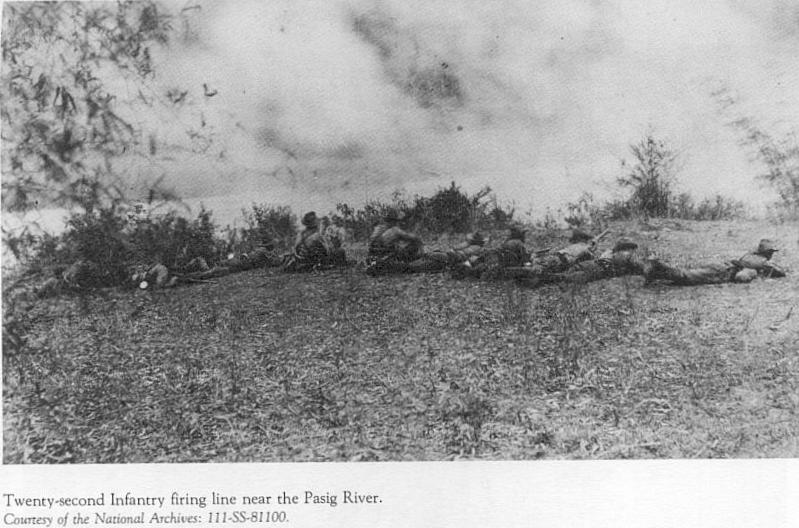
Photo of 22nd Infantry Soldiers during
the fight at Pasig.
This photo originally appeared in the 1904 Regimental history.
**********************
The above narrative is taken from the Regimental Histories of 1904 and 1922, except:
* From the book: Combat Diary EPISODES FROM THE
HISTORY OF THE
TWENTY-SECOND REGIMENT, 1866-1905
by A. B. Feuer
Praeger Publishers, New York, N.Y.
* 1 Combat Diary, pp 87-89
* 2 Combat Diary, pp 89-90
* 3 Combat Diary, p 90-----
* 4 Combat Diary, p 91-----
* 5 Combat Diary, pp 93-94
* 6 Combat Diary, p 94-----
Additional comments by the website editor.
Home | Photos | Battles & History | Current |
Rosters & Reports | Medal of Honor | Killed
in Action |
Personnel Locator | Commanders | Station
List | Campaigns |
Honors | Insignia & Memorabilia | 4-42
Artillery | Taps |
What's New | Editorial | Links |